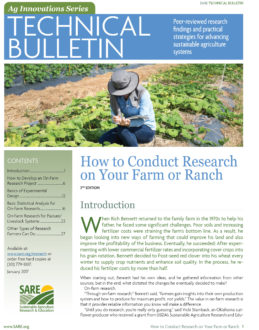For on-farm research projects comparing three or more treatments, a more complex analysis is required than the t-test. You could potentially compare your treatments two at a time using the t-test. For example, in an experiment with three treatments, you could calculate the LSD to compare treatment one and treatment two, two and three, and one and three. Note, however, that you normally would not calculate all of the possible comparisons because doing so will increase your chance of coming to a wrong conclusion. There is a statistical correction that needs to be made in this case. Similarly, in a split-plot experiment, a simple t-test can provide an LSD for comparing main treatments. But this can be quite cumbersome to do by hand, so we recommend using statistical software (see Resources). When discussing your project with your cooperating researcher or Extension agent, make sure to ask them about getting assistance with statistical analysis. See Figure 8 for an example of how the results of three treatments might relate to one another in terms of LSD.
How to Conduct Research on Your Farm or Ranch
Stats for Randomized Complete Block and Split-Plot Designs
SARE Outreach
| 2017 | 32 pages
PDF (1.7 MB)
or call (301) 779-1007 to order.
